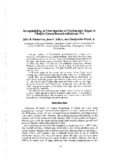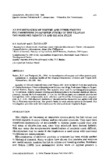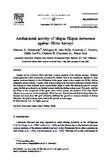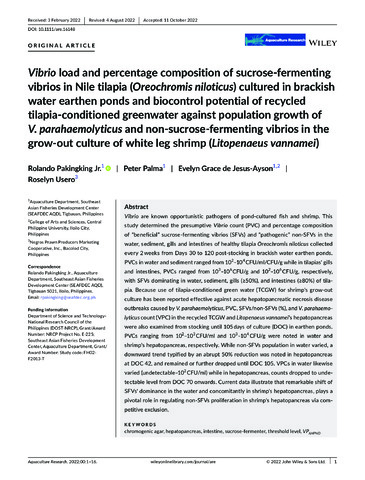Acceptability of five species of freshwater algae to tilapia (Oreochromis niloticus) fry

ရှာဖွေ/ဖွင့်ပါ။
ရက်စွဲ
1985Page views
619
Share
စိတ္တဇ
Unialgal cultures of Oscillatoria quadripunctulata, Chroococcus dispersus, Navicula notha, Euglena elongata, and Chlorella ellipsoidea were fed to tilapia fry for 30 days. Mean weights and survival rates of the fry were highest when given Navicula (105.6 mg, 86%) and Chroococcus (89.1 mg, 90%). Oscillatoria, a filamentous cyanophyte, showed limited acceptability to tilapia fry, possibly because of its larger size in comparison with Chroococcus. Fry fed Chlorella and Euglena did not survive at all.
C14-labeled algae of the above species were fed to tilapia fry of varying ages. Assimilation rates per fry after 24 hours of feeding with a suitable algal species increased with the age of the fry. Moreover, the same trend as in the growth and survival experiments was observed, i.e., the highest assimilation rates were obtained in 40-day old tilapia fry given Navicula and Chroococcus as natural feeds. On the other hand, negligible amounts of the other three algal species tested were assimilated by tilapia fry.
The above results were explained in terms of the enzyme secretion of tilapias. There seemed to be no transition stage in the feeding habit of both fry and adult tilapia. The acceptability of plant matter in the diet of even the early larval stages was demonstrated.
Suggested Citation
Pantastico, J. B., Baldia, J. P., & Reyes Jr., D. (1985). Acceptability of five species of freshwater algae to tilapia (Oreochromis niloticus) fry. In C. Y. Cho, C. B. Cowey, & T. Watanabe (Eds.), Finfish Nutrition in Asia : Methodological Approaches to Research and Development (pp. 136-144). Ottawa, Canada: International Development Research Centre.
ဘာသာရပ်
စုစည်းမှုများ စုစည်းမှုများ
Related items
Showing items related by title, author, creator and subject.
-
An investigation of enzyme and other protein polymorphisms in Japanese stocks of the tilapias Oreochromis niloticus and Tilapia zillii
Basiao, Zubaida U.; Taniguchi, Nobuhiko (Elsevier, 1984)Samples of Oreochromis niloticus and Tilapia zillii were collected from the hatcheries of Osaka Prefecture Fisheries Experimental Station and Shiga Prefecture Fisheries Experimental Station, Japan, respectively. The samples ... -
Antibacterial activity of tilapia Tilapia hornorum against Vibrio harveyi
Tendencia, Eleonor; dela Peña, Milagros R.; Fermin, Armando C.; Lio-Po, Gilda; Choresca, Casiano H., Jr.; Inui, Yasuo (Elsevier, 2004)Disease due to luminous Vibrio has been a major problem of the shrimp industry. Different technologies have been introduced to control the disease. One of the techniques reported to work against luminous bacteria in the ... -
Vibrio load and percentage composition of sucrose‐fermenting vibrios in Nile tilapia (Oreochromis niloticus) cultured in brackish water earthen ponds and biocontrol potential of recycled tilapia‐conditioned greenwater against population growth of V. parahaemolyticus and non‐sucrose‐fermenting vibrios in the grow‐out culture of white leg shrimp (Litopenaeus vannamei)
Pakingking, Rolando V., Jr.; Palma, Peter; de Jesus-Ayson, Evelyn Grace T.; Usero, Roselyn (Wiley, 2022-10-20)Vibrio are known opportunistic pathogens of pond-cultured fish and shrimp. This study determined the presumptive Vibrio count (PVC) and percentage composition of “beneficial” sucrose-fermenting vibrios (SFVs) ...



